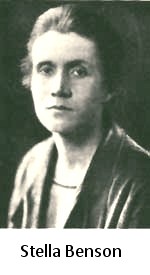
 In Stravinsky’s Lunch, Modjeska looks at how two near-contemporaries of the two women in the painting (the painter’s sisters), Stella Bowen and Grace Cossington Smith — both Australians, both painters — took on the century they encountered and carved out lives and careers very different from the conventions of the Victorian world in which they were raised. Modjeska refers to the book as “a koan in my own practice as a woman and writer.” The choice of the term is apt, as Stravinsky’s Lunch is a book that raises many questions and finds few definitive answers to them.
In Stravinsky’s Lunch, Modjeska looks at how two near-contemporaries of the two women in the painting (the painter’s sisters), Stella Bowen and Grace Cossington Smith — both Australians, both painters — took on the century they encountered and carved out lives and careers very different from the conventions of the Victorian world in which they were raised. Modjeska refers to the book as “a koan in my own practice as a woman and writer.” The choice of the term is apt, as Stravinsky’s Lunch is a book that raises many questions and finds few definitive answers to them.
Questions such as those raised by the story of Stravinsky’s lunch, which Modjeska first heard over a restaurant meal with other writers and artists. It’s not really a story, so much as the fact that when the composer Igor Stravinsky was working on a composition, he insisted that his family eat lunch in silence. “All artists are selfish,” wrote Robert Craft in Stravinsky: Chronicle of a Friendship (1972), “they must be, to get their work done. And they sacrifice the people around them.” for Modjeska, Stravinsky’s selfishness raises larger questions: “What are we prepared to ask of ourselves and of those who love us, what value we put on love and what value we put on art; what compromises we will make; which gods we will appease?”
Stella Bowen offers an example of a woman who, at first, sacrificed herself willingly on the altars of love and art. She happily entered into a relationship with the writer Ford Madox Ford, taking on the many domestic burdens of their rustic, near-penniless existence, in return for the sake of his love and his company: “… to have the run of a mind of that calibre … was a privilege for which I am still trying to say ‘thank you,'” she wrote in her memoir, Drawn from Life. But she also sacrificed her own development as an artist, as tending to Ford’s needs left her with little time and energy for her own work:
Ford never understood why I found it so difficult to paint whilst I was with him. He thought I lacked the will to do it at all costs. That was true, but he did not realise that if I had had the will to do it at all costs, my life would have been oriented quite differently. I should not have been available to nurse him through the daily strain of his own work; to walk and talk with him whenever he wanted, and to stand between him and circumstances. Pursuing an art is not just a matter of finding the time — it is a matter of having a free spirit to bring to it.
When, after one too many affairs with other women on Ford’s part, Bowen broke off their relationship, he failed to understand what all the fuss was about. As Modjeska puts it, he didn’t realize “that the qualities that had drawn him to her in the first place — her courage, her intelligence, her engagement with life — were precisely those that would take her away from him.” And that courage and intelligence were also what allowed her to produce her best work when she herself was free to focus. Yet, as is clear from Drawn from Life, Bowen never looked upon her time with Ford with regret, certainly not when she thought of their daughter. “Was Love the one, in the end, that she chose?” Or did she even chose one or the other? “Is choosing what she did?”
When I first read the story of Grace Cossington Smith that makes up the second half of Stravinsky’s Lunch, I was quite disappointed. There was none of the drama of Stella Bowen’s life. “No husbands. No babies. No affairs. No scandals. No cafes in Paris…. In the prejudices of her time, she was, simply, a spinster.” Smith spent most of her life in the same house with her parents and two of her three sisters. Most days, she painted scenes and people she saw around her in Sydney and the nearby country and seaside, working in a small studio her father had built at the back of their yard. She was over sixty before she was accepted as a serious artist of her own generation, over seventy when she was finally recognized as one of the greatest Australian painters of her century.
Much of Smith’s story is a matter of producing painting after painting, moving first towards a striking mix of realism and abstraction, as illustrated by her 1926 painting, Trees. Smith said she was trying to paint all sides of a tree at once. When it appeared in her first solo show, one newspaper critic condemned it as a “freak.” Modjeska sees the work as revealing Smith’s keen eye for the dual nature of her Australian world: “For this was a young woman who understood both the settled pleasures of a garden with its bloom of peach, and the hectic tangle of branch and leaf, the mysterious possibilities that lay beyond, in bush and gully.”
As she grew older, Smith turned from subjects such as the Sydney Harbour Bridge to her immediate surroundings, painting the rooms in her family home — always with at least one window or door opening out into the world, but always from the perspective of someone on the inside. She experimented with color, settling on yellow as her primary tone, offset with blue (which is why it’s surprising that Modjeska doesn’t quote the opening phrase from Drawn from Life: “The land where I was born is a blue and yellow country”).

But there is another story that Modjeska reveals. Of Smith’s three sisters, one married early and another took on a lifetime profession as a nurse. But her sister Madge stayed at home and cared for their parents and Grace, and after their parents died, for Grace alone. It was Madge who cooked the meals and saw that the rooms were cleaned and laundry washed and ironed. Modjeska reprints a photo of Grace, Madge, and their father from 1919. It’s one of those family photos that, though accidentally and perhaps misleadingly, seems to betray a secret. “There is Grace with her strong, intelligent face lifted to the sun. Madge’s lowered head is shrouded in misery so intense it seems to burn the paper their images are printed on…. You can tell at a glance that there’d be no question of Grace taking over the kitchen.”
So, despite forging a career in art that was very much of her own shaping, deliberately enforcing her isolation so that she could focus on her work — focus to the point that her paintings from her last decades all depict scenes less than a few yards from her own home — Smith did, in her own way, insist on a form of Stravinsky’s lunch. No wonder that when Madge accompanied Grace on a trip to England in 1949, she found a widower in need of a wife and married him, leaving Grace to return to Australia alone.
Yet Modjeska admits that her attitude toward the story of Stravinsky’s lunch changed in the course of writing the book, and, in particular because of Smith’s example. The nature of the book as a koan is revealed in her realization that the story “not only buys into a way of thinking that would separate art from life, with art striding above and beyond, transcending the ordinary and humble, but it sets life against art, or art against life.” Smith never involved herself in artistic movements and stayed rooted to the home and family she knew. And as her energies diminished with age, she focused on the things she saw immediately around her: her bed, her table, her windows, her mirror.
Some reviewers objected to Modjeska’s interjection of herself, of her own reflections, into her accounts of the lives and careers of Bowen and Smith. But Stravinsky’s Lunch is not really a work of biography as much as an exercise in understanding — and as much Modjeska’s self-understanding as her understanding of the two women she portrays. In 1999, perhaps it was just slightly too early for critics to be comfortable with a work that did not fit neatly into the boundaries of one particular genre, but I think we are seeing now a proliferation of books that sweep across genre boundaries with never a second thought. I hope today’s readers will be ready to seek out a copy of Stravinsky’s Lunch and enjoy it as thoroughly as I did.






 The book opens innocently. Benson vouches for the real existence of the count and offers a synopsis of his noble pedigree (quite unconnected with that of the famous painter) as a member of “one of the most distinguiched aristocratic famelys of Europe.” She describes meeting him while he was a patient in a charity hospital in Hong Kong. According to Marlene Baldwin Davis’
The book opens innocently. Benson vouches for the real existence of the count and offers a synopsis of his noble pedigree (quite unconnected with that of the famous painter) as a member of “one of the most distinguiched aristocratic famelys of Europe.” She describes meeting him while he was a patient in a charity hospital in Hong Kong. According to Marlene Baldwin Davis’